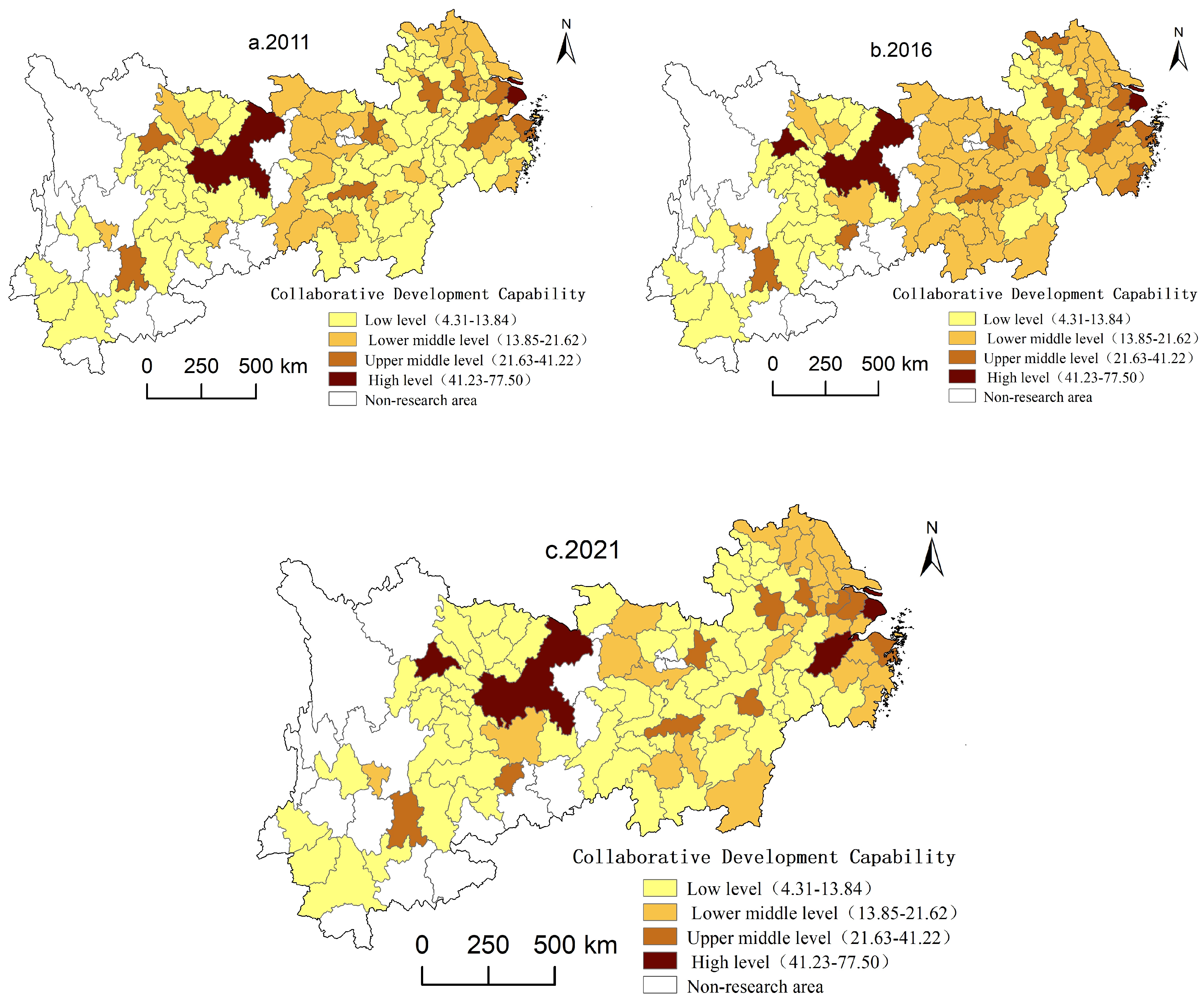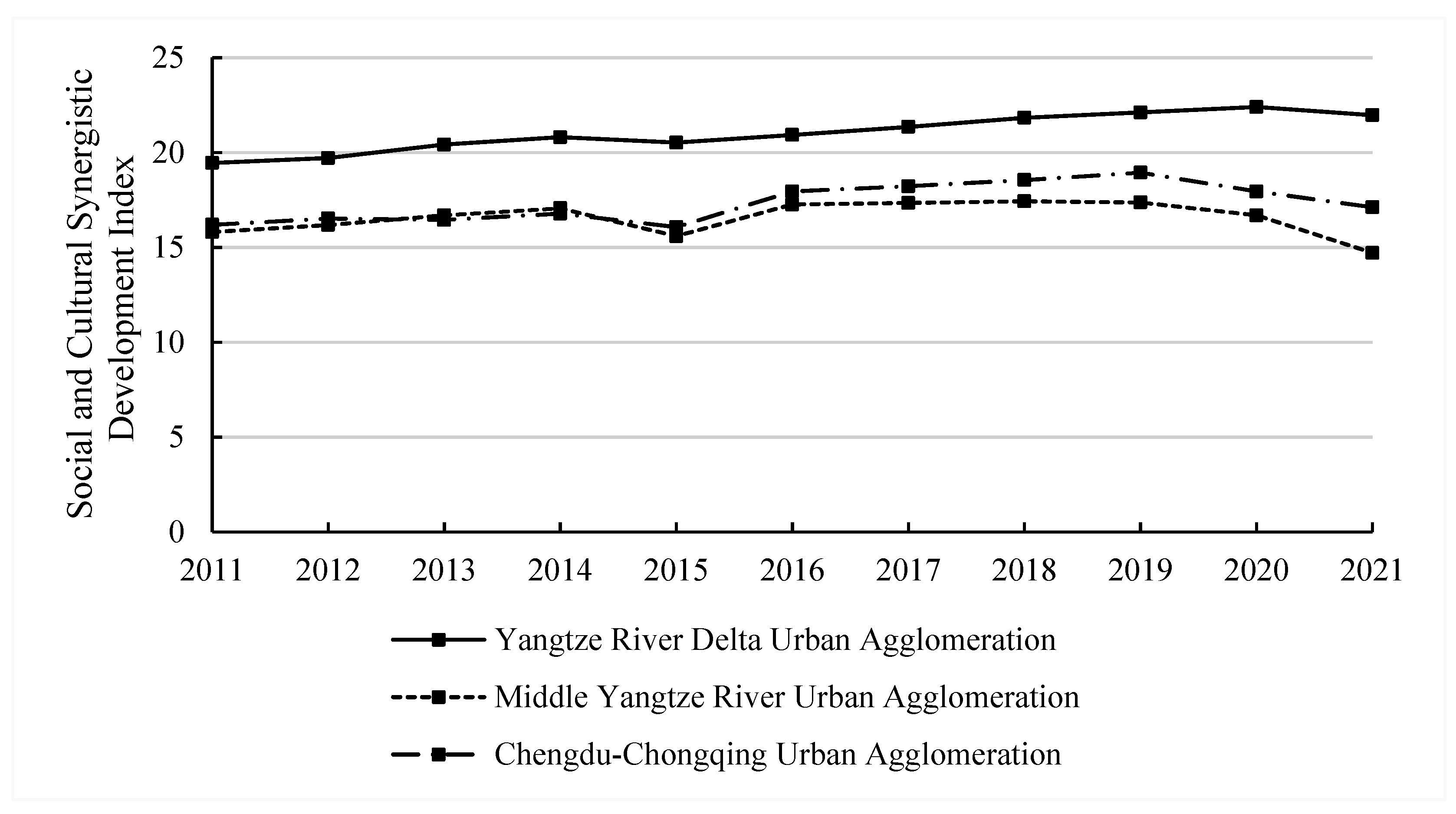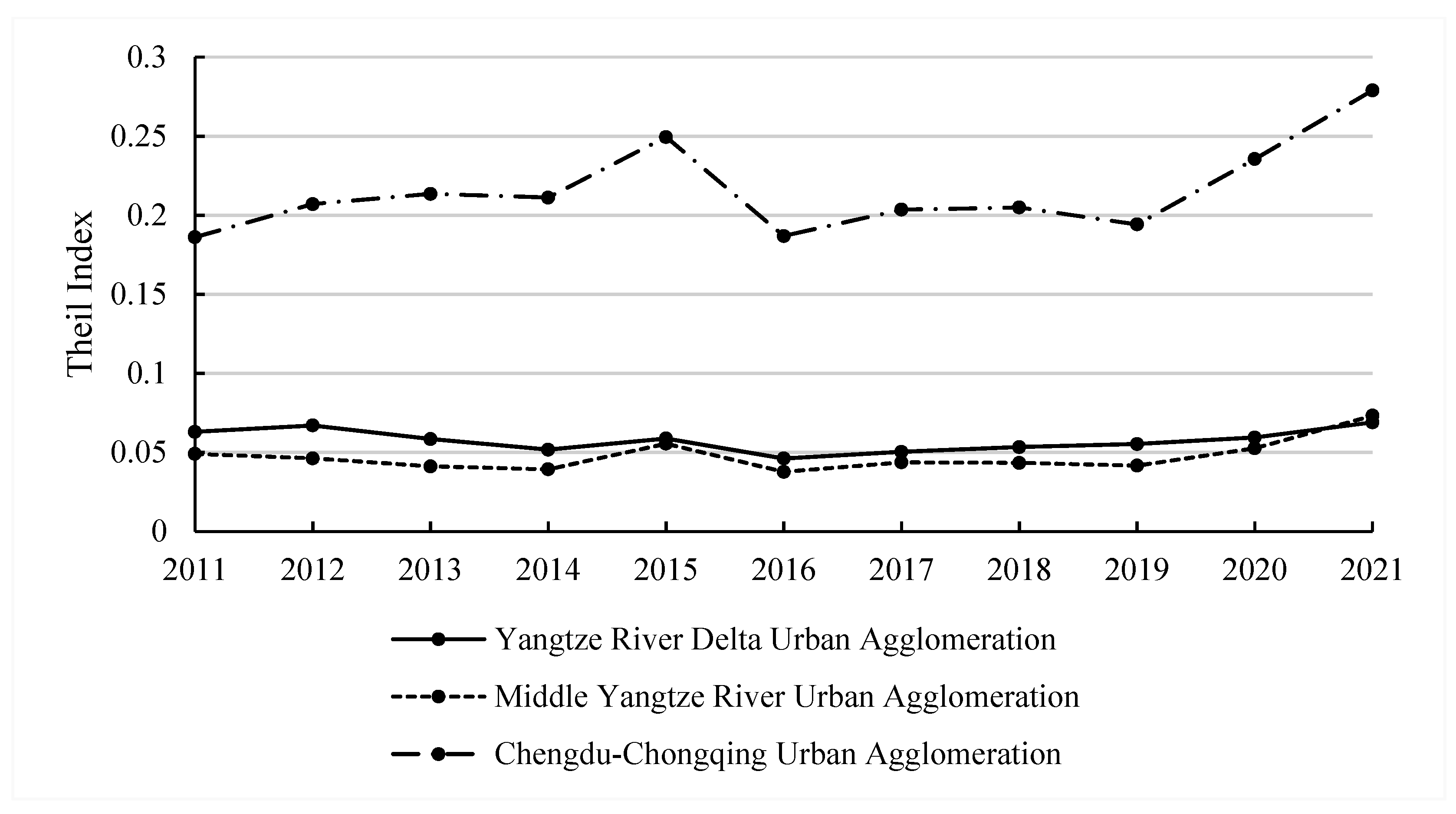Evaluation of Socially and Culturally Coordinated Development in Cities of Yangtze River Economic Belt and Its Spatial Correlation
Abstract
1. Introduction
2. Materials and Methods
2.1. Indicator System Construction
2.2. Entropy Weight Method (EWM)
2.3. Theil Index
2.4. Spatial Autocorrelation Analysis
3. Results
3.1. Temporal Evolution Characteristics of Sociocultural Coordination
3.1.1. Overall Improvement in the Level of Sociocultural Coordination
3.1.2. Significant Differences in Coordination Levels Across Sociocultural Domains
3.1.3. Cities Show Considerable Potential for Enhancing Synergistic Development Capacity
- Note: To visualize distribution of urban composite scores, score–rank diagram was constructed. Rank is derived directly from sorted score values, and diagram serves primarily as comparative tool.
3.2. Spatial Differentiation and Inter-City Linkages of Social and Cultural Coordination
3.2.1. The Overall Pattern of Urban Coordination Shows High in the East, Low in the West, with a Core–Periphery Distribution
3.2.2. Disparities in Coordinated Development Levels of City Clusters in the Yangtze River Economic Belt
3.2.3. Significant Spatial Agglomeration Effect
3.2.4. Spatial Heterogeneity and Regional Differences
4. Conclusions
4.1. Discussion
4.2. Implications and Recommendations
4.2.1. Deepen Cultural Infrastructure and Identity Construction
4.2.2. Cultivate Cultural Industry Clusters and Cross-Regional Linkages
4.2.3. Advance Cross-Industry Integration to Expand Cultural Support Functions
4.2.4. Leverage Scientific and Educational Resources to Drive Innovation Diffusion
4.2.5. Stimulate Cultural Consumption and Strengthen Public Service Systems
Author Contributions
Funding
Data Availability Statement
Conflicts of Interest
References
- Xinhua News Agency. Xi Jinping Presided over a Symposium on Comprehensively Promoting the Development of the Yangtze River Economic Belt and Delivered an Important Speech [EB/OL]. Available online: https://www.gov.cn/xinwen/2020-11/15/content_5561711.htm?eqid=d6119ca80000e15d0000000664756bd0 (accessed on 15 January 2024).
- Zhou, S. From Yellow River Culture to Yangtze River Culture: Thoughts on the Shift of Chinese Cultural Focus and Its Contemporary Shift[EB/OL]. Available online: http://philosophychina.cssn.cn/fzxk/whzx/201507/t20150714_2730888.shtml (accessed on 11 February 2024).
- Zhang, Y. A Deep Understanding of the Connotation of Yangtze River Culture [N]. Study Times, 8 February 2021; A5 Edition. [Google Scholar]
- Si, H. A discussion on Yangtze River culture and its research. Soc. Sci. 1991, 5, 63–65. [Google Scholar]
- Xiao, J.; Shang, Z.; Zhang, Z.; Xiao, S.; Jia, X. A preliminary study on the mechanism of the Liangzhu culture’s migration across the Yangtze river. Front. Earth Sci. 2023, 11, 1121469. [Google Scholar] [CrossRef]
- Lin, Y.; Wang, X. Regional characteristics and cultural effects of Yangtze River culture in Qing Dynasty. Yangtze River Cult. 2001, 10, 34–37. [Google Scholar]
- Du, Y. Research on the protection of intangible cultural heritage with hidden economic value in the Yangtze River Economic Belt. J. Qinghai Normal Univ. 2019, 41, 69–76. [Google Scholar]
- Nie, Z.; Dong, T.; Pan, W. Spatial differentiation and geographical similarity of traditional villages—Take the Yellow River Basin and the Yangtze River Basin as examples. PLoS ONE 2024, 19, e0295854. [Google Scholar] [CrossRef]
- Xiong, Y.; Shi, P.; Li, X. Dynamic study on the construction level of “Beautiful China” in the Yangtze River economic belt. East China Econ. Manag. 2017, 9, 5–13. [Google Scholar]
- Zeng, G.; Cao, X.; Zhu, Y. Coordinated development pattern and prospects of cities in the Yangtze River economic belt. Resour. Environ. Yangtze River Basin 2022, 31, 1685–1693. [Google Scholar]
- Paasi, A. Bounded spaces in the mobile world: Deconstructing ‘regional identity’. Tijdschr. Voor Econ. En Sociale Geografie 2002, 93, 137–148. [Google Scholar] [CrossRef]
- Yin, J.; Zheng, X. Safety assessment and safety pattern of tourism industry ecosystem in the Yangtze River Economic Belt. East Chin. Econ. Manag. 2017, 4, 60–65. [Google Scholar]
- Ma, N.; Yao, Y.; Shen, T. Differentiated path of economic synergistic development among cities in the Yangtze River Economic Belt. Econ. Geogr. 2023, 43, 79–90. [Google Scholar]
- Huang, H.; Wang, R.; Xiao, Y. Synergistic evolution and influencing factors of scientific and technological innovation and ecological efficiency in the Yangtze River economic belt. Resour. Environ. Yangtze River Basin 2024, 33, 671–686. [Google Scholar]
- Liu, Z.; Chen, C.; Ye, M. Promoting the high-quality development of the Yangtze River economic belt by regional synergy and integration. Contemp. Financ. Econ. 2024, 2, 3–10. [Google Scholar]
- Yu, Z.; Zhao, Q. Research on the coordinated governance mechanism of cross-regional and cross-basin ecological compensation in the Yangtze River Delta. Int. J. Environ. Res. Public Health 2022, 19, 9881. [Google Scholar] [CrossRef]
- Qiao, W.; Guan, W.; Huang, X. Assessing the potential impact of land use on carbon storage driven by economic growth: A case study in Yangtze River Delta urban agglomeration. Int. J. Environ. Res. Public Health 2021, 18, 11924. [Google Scholar] [CrossRef]
- Haken, H. Synergetik: Eine Einführung. Nichtgleichgewichts-Phasenübergänge und Selbstorganisation in Physik, Chemie und Biologie; Springer: Berlin/Heidelberg, Germany, 2013. [Google Scholar]
- Haken, H. Synergetics: An Introduction Nonequilibrium Phase Transitions and Self-Organization in Physics, Chemistry and Biology; Springer: Berlin/Heidelberger, Germany, 1977; pp. 186–194. [Google Scholar]
- Zhang, K.; Cai, Z. The history review, limiting factors and future direction of the collaborative development of the Beijing-Tianjin-Hebei region development. Hebei Acad. J. 2014, 34, 101–105. [Google Scholar]
- Ma, H. Evolutionary networks of interurban technological collaboration across Chinese city-regions. Reg. Stud. Reg. Sci. 2022, 9, 457–460. [Google Scholar] [CrossRef]
- Hong, W.; Li, Y.; Yang, X.; Guo, R.; Liang, M.; Li, X. Identification of intercity ecological synergy regions and measurement of the corresponding policy network structure: A network analysis perspective. Landscape Urban Plan. 2024, 245, 105008. [Google Scholar] [CrossRef]
- Xu, S.; Liu, Q.; Sun, H. Economic coordination development from the perspective of cross-regional urban agglomerations in China. Reg. Sci. Policy Pract. 2022, 14, 36–59. [Google Scholar] [CrossRef]
- Zhou, W.; Dong, H.; An, S. Mechanism and spatial differentiation characteristics of coordinated development in the Beijing-Tianjin-Hebei urban agglomeration: Calculation and evaluation based on DEA model. China Soft Sci. 2023, 8, 73–85. [Google Scholar]
- Storm, J.A.J. Metamodernism. In The Future of Theory; The University of Chicago Press: Chicago, IL, USA, 2021; 328p, ISBN 978-0-226-78665-0. [Google Scholar]
- Matlovič, R.; Matlovičová, K. The Metamodern Shift in Geographical Thought: Oscillatory Ontology and Epistemology, Post-disciplinary and Post-paradigmatic Perspectives. Folia Geogr. 2025, 67, 22–69. [Google Scholar]
- Tang, T.; Lin, X.; Lu, M. Analysis of the dynamic mechanism of trans-boundary pollution collaborative control in the Yangtze River Economic Belt. Environ. Res. 2024, 257, 119327. [Google Scholar] [CrossRef] [PubMed]
- Zhao, C.; Liu, Z. Spatial distribution characteristics of digital economy enterprises in urban agglomerations. Econ. Geogr. 2024, 44, 126–133. [Google Scholar]





| Goal Layer | Factor Layer | Indicator Layer | Unit | Direction |
|---|---|---|---|---|
| Social and Cultural Coordination Development of the Yangtze River Economic Belt | Educational Resources | Educational Expenditure | 10,000 RMB | + |
| Number of General Higher Education Institutions | Institution | + | ||
| Number of Primary and Secondary Schools | Institution | + | ||
| Healthcare Conditions | Number of Hospitals | Institution | + | |
| Number of Practicing or Assistant Physicians | Person | + | ||
| Number of Hospital Beds | Beds | + | ||
| Social Security | Number of Urban Employee Pension Insurance Participants | Ten Thousand People | + | |
| Number of Unemployment Insurance Participants | Ten Thousand People | + | ||
| Urban–Rural Differences | Urbanization Rate | % | + | |
| Urban–Rural Income Gap | Yuan | − | ||
| Cultural Integration | Number of People Employed in the Cultural Industry | Ten Thousand People | + | |
| Number of Books in Public Libraries | Thousand Books | + | ||
| Number of National Intangible Cultural Heritage Items | Item | + |
| Year | Sociocultural | Education Resources | Medical Conditions | Social Security | Urban–Rural Differences | Cultural Integration |
|---|---|---|---|---|---|---|
| 2011 | 15.66 | 12.21 | 14.17 | 5.33 | 38.57 | 8.00 |
| 2012 | 15.99 | 12.65 | 14.7 | 5.02 | 39.19 | 8.37 |
| 2013 | 16.56 | 12.79 | 13.42 | 5.28 | 43.02 | 8.28 |
| 2014 | 16.87 | 13.06 | 13.53 | 5.58 | 44.19 | 7.99 |
| 2015 | 15.65 | 13.30 | 13.51 | 5.32 | 37.73 | 8.39 |
| 2016 | 17.25 | 13.03 | 13.71 | 4.68 | 46.94 | 7.88 |
| 2017 | 17.46 | 13.29 | 13.66 | 4.79 | 47.76 | 7.81 |
| 2018 | 17.61 | 13.17 | 13.44 | 5.06 | 48.42 | 7.97 |
| 2019 | 17.75 | 12.98 | 13.54 | 5.17 | 49.03 | 8.02 |
| 2020 | 17.03 | 13.57 | 13.64 | 5.44 | 44.33 | 8.19 |
| 2021 | 15.63 | 13.09 | 13.60 | 5.92 | 37.49 | 8.04 |
| Year | Sociocultural | Education Resources | Medical Conditions | Social Security | Urban–Rural Differences | Cultural Integration |
|---|---|---|---|---|---|---|
| 2011 | 0.1148 | 0.1969 | 0.3097 | 1.0164 | 0.0319 | 0.5999 |
| 2012 | 0.1154 | 0.1937 | 0.3042 | 1.1113 | 0.0323 | 0.6030 |
| 2013 | 0.1029 | 0.1992 | 0.3410 | 1.0694 | 0.0247 | 0.6392 |
| 2014 | 0.1010 | 0.197 | 0.3295 | 1.0218 | 0.0250 | 0.5997 |
| 2015 | 0.1255 | 0.1914 | 0.3234 | 1.1096 | 0.0294 | 0.6011 |
| 2016 | 0.0926 | 0.1850 | 0.3326 | 1.1556 | 0.0186 | 0.5800 |
| 2017 | 0.0975 | 0.1813 | 0.4202 | 1.1537 | 0.0173 | 0.5878 |
| 2018 | 0.0995 | 0.1920 | 0.4222 | 1.1274 | 0.0170 | 0.5899 |
| 2019 | 0.0987 | 0.1955 | 0.4045 | 1.1156 | 0.0161 | 0.6028 |
| 2020 | 0.1179 | 0.1873 | 0.3905 | 1.1248 | 0.0271 | 0.5846 |
| 2021 | 0.1545 | 0.2164 | 0.4123 | 1.1271 | 0.0390 | 0.5757 |
| Rank | City | Score | Rank | City | Score | Rank | City | Score |
|---|---|---|---|---|---|---|---|---|
| 1 | Shanghai | 75.88 | 38 | Lianyungang | 14.13 | 75 | Shangrao | 11.47 |
| 2 | Chongqing | 58.64 | 39 | Zhuzhou | 14.04 | 76 | Yibin | 11.44 |
| 3 | Chengdu | 56.98 | 40 | Ganzhou | 13.99 | 77 | Fuzhou | 11.43 |
| 4 | Hangzhou | 44.37 | 41 | Zunyi | 13.84 | 78 | Luzhou | 11.38 |
| 5 | Wuhan | 40.48 | 42 | Jingzhou | 13.82 | 79 | Xianning | 11.35 |
| 6 | Nanjing | 35.05 | 43 | Dazhou | 13.8 | 80 | Anqing | 11.22 |
| 7 | Changsha | 31.36 | 44 | Yueyang | 13.72 | 81 | Huaibei | 11.18 |
| 8 | Suzhou | 31.35 | 45 | Shaoyang | 13.37 | 82 | Xuancheng | 10.95 |
| 9 | Hefei | 27.93 | 46 | Suizhou | 13.37 | 83 | Huainan | 10.92 |
| 10 | Ningbo | 26.55 | 47 | Ezhou | 13.36 | 84 | Leshan | 10.85 |
| 11 | Kunming | 25.76 | 48 | Changde | 13.3 | 85 | Ya’an | 10.75 |
| 12 | Wuxi | 23.53 | 49 | Xiangtan | 13.22 | 86 | Meishan | 10.55 |
| 13 | Nanchang | 21.96 | 50 | Mianyang | 12.95 | 87 | Bengbu | 10.53 |
| 14 | Guiyang | 21.88 | 51 | Jiujiang | 12.95 | 88 | Bijie | 10.48 |
| 15 | Wenzhou | 20.8 | 52 | Huangshan | 12.88 | 89 | Fuyang | 10.43 |
| 16 | Xuzhou | 19.95 | 53 | Nanchong | 12.84 | 90 | Jingdezhen | 10.37 |
| 17 | Changzhou | 18.8 | 54 | Lishui | 12.76 | 91 | Loudi | 9.91 |
| 18 | Nantong | 18.58 | 55 | Ma’anshan | 12.72 | 92 | Jian | 9.78 |
| 19 | Suqian | 18.47 | 56 | Jingmen | 12.7 | 93 | Neijiang | 9.71 |
| 20 | Shaoxing | 18.09 | 57 | Shiyan | 12.63 | 94 | Lu’an | 9.37 |
| 21 | Chizhou | 18.03 | 58 | Chenzhou | 12.54 | 95 | Guang’an | 9.3 |
| 22 | Jinhua | 17.67 | 59 | Yiyang | 12.49 | 96 | Suzhou | 9.18 |
| 23 | Yangzhou | 17.49 | 60 | Xiaogan | 12.45 | 97 | Guangyuan | 9.17 |
| 24 | Yancheng | 17.22 | 61 | Deyang | 12.43 | 98 | Qujing | 8.66 |
| 25 | Zhoushan | 17.18 | 62 | Pingxiang | 12.41 | 99 | Tongren | 8.56 |
| 26 | Jiaxing | 17.16 | 63 | Zigong | 12.15 | 100 | Liupanshui | 8.47 |
| 27 | Yichang | 16.97 | 64 | Yongzhou | 12.09 | 101 | Yuxi | 8.45 |
| 28 | Zhenjiang | 16.56 | 65 | Huangshi | 12.05 | 102 | Ziyang | 8.21 |
| 29 | Xinyu | 16.41 | 66 | Tongling | 12.02 | 103 | Anshun | 8.12 |
| 30 | Wuhu | 15.84 | 67 | Suining | 11.96 | 104 | Bazhong | 8.09 |
| 31 | Panzhihua | 15.52 | 68 | Chuzhou | 11.91 | 105 | Zhaotong | 7.7 |
| 32 | Taizhou (Jiangsu) | 14.55 | 69 | Huaihua | 11.87 | 106 | Bozhou | 7.52 |
| 33 | Hengyang | 14.5 | 70 | Huanggang | 11.82 | 107 | Lijiang | 6.76 |
| 34 | Huzhou | 14.42 | 71 | Yingtan | 11.77 | 108 | Pu’er | 6.68 |
| 35 | Taizhou (Zhejiang) | 14.4 | 72 | Quzhou | 11.76 | 109 | Lincang | 5.63 |
| 36 | Huai’an | 14.26 | 73 | Zhangjiajie | 11.71 | 110 | Baoshan | 4.31 |
| 37 | Xiangyang | 14.21 | 74 | Yichun | 11.62 |
| 2011 | 2016 | 2021 | ||||
|---|---|---|---|---|---|---|
| Coordinated Development Level | Global Moran’s I | p-Value | Global Moran’s I | p-Value | Global Moran’s I | p-Value |
| Overall Level | 0.0096 | 0.1617 | 0.0060 | 0.2656 | 0.0128 | 0.0511 |
| Educational Resources | 0.0053 | 0.3119 | −0.0020 | 0.6192 | 0.0167 | 0.0747 |
| Medical Conditions | −0.0055 | 0.7868 | −0.0092 | 0.9981 | −0.0079 | 0.9259 |
| Social Security | 0.0220 | 0.0095 | 0.0257 | 0.0028 | 0.0151 | 0.0655 |
| Urban–Rural Disparities | 0.0824 | 0.0000 | 0.1099 | 0.0000 | 0.1144 | 0.0000 |
| Cultural Integration | 0.0344 | 0.0006 | 0.0255 | 0.0083 | 0.0242 | 0.0104 |
Disclaimer/Publisher’s Note: The statements, opinions and data contained in all publications are solely those of the individual author(s) and contributor(s) and not of MDPI and/or the editor(s). MDPI and/or the editor(s) disclaim responsibility for any injury to people or property resulting from any ideas, methods, instructions or products referred to in the content. |
© 2025 by the authors. Licensee MDPI, Basel, Switzerland. This article is an open access article distributed under the terms and conditions of the Creative Commons Attribution (CC BY) license (https://creativecommons.org/licenses/by/4.0/).
Share and Cite
Yi, Z.; Cao, X.; Qin, L. Evaluation of Socially and Culturally Coordinated Development in Cities of Yangtze River Economic Belt and Its Spatial Correlation. Land 2025, 14, 1226. https://doi.org/10.3390/land14061226
Yi Z, Cao X, Qin L. Evaluation of Socially and Culturally Coordinated Development in Cities of Yangtze River Economic Belt and Its Spatial Correlation. Land. 2025; 14(6):1226. https://doi.org/10.3390/land14061226
Chicago/Turabian StyleYi, Zhenzhen, Xianzhong Cao, and Liuting Qin. 2025. "Evaluation of Socially and Culturally Coordinated Development in Cities of Yangtze River Economic Belt and Its Spatial Correlation" Land 14, no. 6: 1226. https://doi.org/10.3390/land14061226
APA StyleYi, Z., Cao, X., & Qin, L. (2025). Evaluation of Socially and Culturally Coordinated Development in Cities of Yangtze River Economic Belt and Its Spatial Correlation. Land, 14(6), 1226. https://doi.org/10.3390/land14061226





